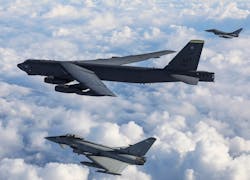Collins Aerospace to build and maintain nuclear-hardened VLF military SATCOM radios for strategic bombers
HANSCOM AIR FORCE BASE, Mass. – Military communications experts at Collins Aerospace will build, upgrade, and maintain secure and jam-resistant very low frequency (VLF) radios U.S. Air Force strategic bomber aircraft to enable the planes to communicate securely with national command authorities while on long-range missions.
Officials of the U.S. Air Force Nuclear War Center at Hanscom Air Force Base, Mass., are awarding a $99.5 million contract to Collins Aerospace for Common Very Low Frequency (VLF)/Low Frequency Increment 1 Air Force Nuclear Weapons Center for VLF modernization production/interim contractor support and sustainment for the B-2, B-52, and potential future aircraft.
U.S. strategic bombers typically communicate over Advanced Extremely High-Frequency (AEHF) system satellite communications (SATCOM) links, as well as the legacy MILSTAR and military UHF satellite constellations.
Collins Aerospace began full-scale development of the Common Very Low Frequency Receiver (CVR) program in late 2013, which involved modifying, qualifying, and testing a B-2 bomber VLF communications system, consisting of a terminal and receiver, antenna, human machine interface (HMI) display, and ancillary cabling, rack, and equipment to enable receipt and display of emergency action messages.
Collins Aerospace experts also have performed systems engineering and requirements definition, prototype fabrication, qualification testing, airworthiness certification, and flight testing of the B-2 bomber's CVR.
Very low frequency communications are among the most durable and reliable communications modes for military use. Although VLF sends data relatively slowly, it is designed to survive and operate through nuclear explosions.
The CVR that Collins Aerospace built for the B-2 bomber is bridging between the UHF SATCOM, MILSTAR, and the AEHF SATCOM systems, Air Force officials say.
Collins Aerospace engineers have designed the B-2 CVR system to operate in the airborne nuclear combat environment, be secure, and be survivable, Air Force officials say. It is nuclear-hardened and meets stringent cryptographic requirements.
On this contract Collins Aerospace will do the work in Richardson, Texas, and should be finished by November 2033. For more information contact Collins Aerospace online at www.collinsaerospace.com, or the Air Force Nuclear War Center at www.afnwc.af.mil.
About the Author
John Keller
Editor-in-Chief
John Keller is the Editor-in-Chief, Military & Aerospace Electronics Magazine--provides extensive coverage and analysis of enabling electronics and optoelectronic technologies in military, space and commercial aviation applications. John has been a member of the Military & Aerospace Electronics staff since 1989 and chief editor since 1995.
